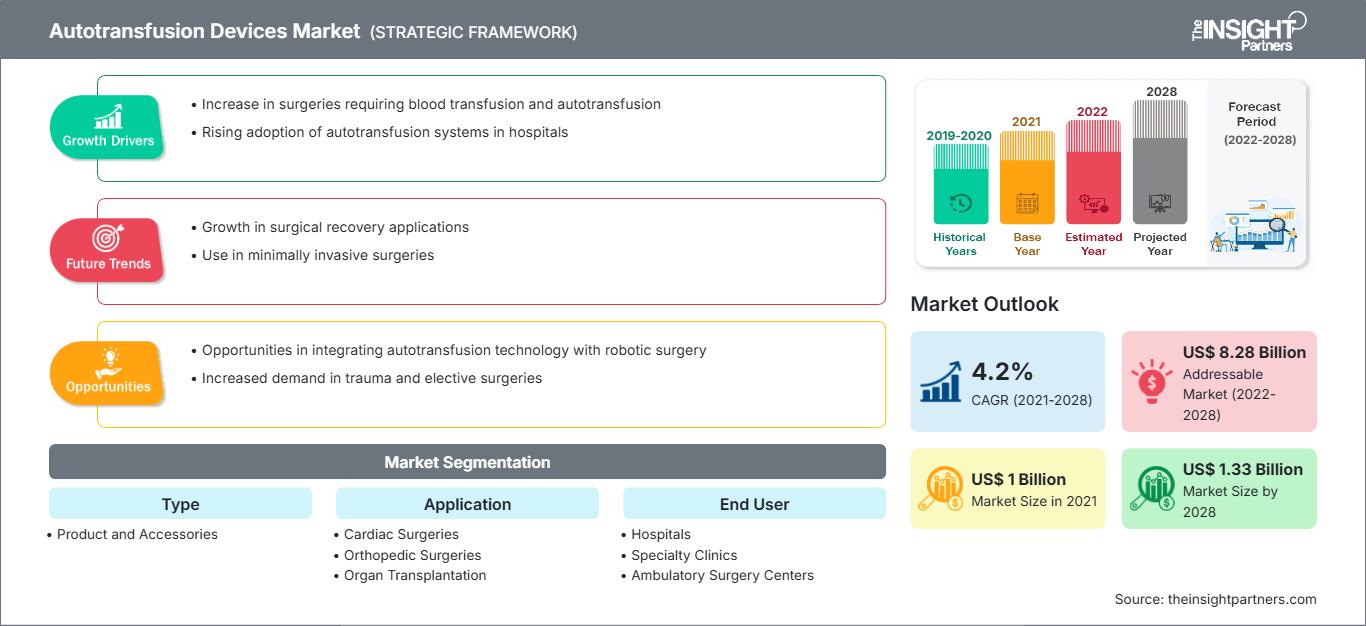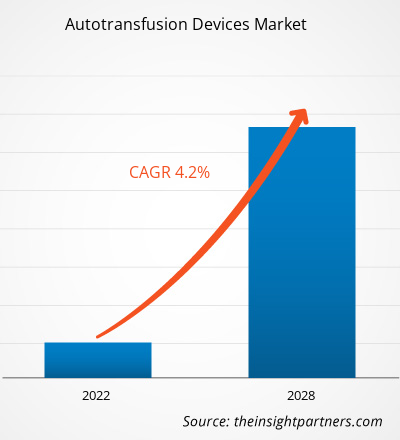Si prevede che il mercato dei dispositivi per autotrasfusione crescerà da 1.000,26 milioni di dollari nel 2021 a 1.331,99 milioni di dollari entro il 2028; si stima una crescita a un CAGR del 4,2% dal 2021 al 2028.
Il trapianto di organi è una procedura chirurgica eseguita in caso di insufficienza d'organo. Solitamente, il trapianto di organi viene eseguito per organi come cuore, fegato e reni; tuttavia, con l'aumento dei casi di malattie croniche, il trapianto è necessario anche per altri organi come polmoni, pancreas, cornea e tessuti vascolari. Queste procedure richiedono generalmente ore e comportano una notevole perdita di sangue; l'autotrasfusione è uno dei metodi più efficaci per prevenire la perdita di sangue. Secondo la United Network for Organ Sharing (UNOS), i trapianti di organi effettuati negli Stati Uniti sono aumentati costantemente, con oltre 41.000 trapianti eseguiti nel 2021. Analogamente, secondo i dati del World Transplant Registry, la Spagna ha rappresentato il 20% di tutte le donazioni di organi nell'UE nel 2019 e il 6% delle donazioni mondiali. Il tasso di donazione di organi in Australia è migliorato negli ultimi anni, raggiungendo i 21,8 donatori per milione di abitanti nel 2019.
Personalizza questo rapporto in base alle tue esigenze
Potrai personalizzare gratuitamente qualsiasi rapporto, comprese parti di questo rapporto, o analisi a livello di paese, pacchetto dati Excel, oltre a usufruire di grandi offerte e sconti per start-up e università
Mercato dei dispositivi di autotrasfusione: Approfondimenti strategici

-
Ottieni le principali tendenze chiave del mercato di questo rapporto.Questo campione GRATUITO includerà l'analisi dei dati, che vanno dalle tendenze di mercato alle stime e alle previsioni.
Analogamente, il Canada conta 22,2 donatori per milione di abitanti e la sua situazione è in costante miglioramento, in parte grazie al numero di "medici addetti alle donazioni", ovvero medici di terapia intensiva responsabili della donazione di organi. Secondo il Registro Mondiale dei Trapianti, la Cina contava 5.818 donatori nel 2019, ovvero 4,1 per milione di abitanti, mentre l'India ne contava 715, ovvero 0,5 per milione di abitanti. D'altra parte, la Russia ha registrato un tasso leggermente superiore, pari a 5,1 donatori per milione di abitanti. Il partenariato pubblico-privato, in collaborazione con i coordinatori dei trapianti, ha contribuito in modo significativo al miglioramento del trapianto di organi. Sia i paesi in via di sviluppo che quelli sviluppati hanno registrato un aumento degli interventi chirurgici di trapianto di organi. Ad esempio, paesi in via di sviluppo come India e Singapore stanno emergendo come destinazioni di turismo medico nella regione Asia-Pacifico. I paesi stanno progredendo nell'offerta di trattamenti medici migliori e avanzati. Pertanto, la crescente necessità di trapianti di organi è uno dei fattori chiave che determinano la domanda di dispositivi diagnostici per i trapianti, come i dispositivi per autotrasfusione.
Il processo di autotrasfusione prevede la reinfusione del sangue del paziente. Il sangue viene prelevato dalla cavità peritoneale o dalla regione toracica. Il processo può essere eseguito prima dell'intervento chirurgico, durante e dopo l'intervento, utilizzando il sistema di autotrasfusione. Procedure mediche, come la sostituzione articolare, la chirurgia spinale e quella cardiaca, tra le altre, richiedono l'autotrasfusione. Questa contribuisce a ridurre il rischio di infezioni ed elimina i problemi e le complicazioni associati alla conservazione e alla somministrazione di sangue omologo da donatore. Contribuisce a prevenire la trasmissione di malattie trasmesse dal sangue ai pazienti.
Market Insights Sviluppi tecnologici nei dispositivi per autotrasfusione
I dispositivi per autotrasfusione vengono solitamente impiegati durante interventi chirurgici che richiedono lunghe ore, come il trapianto di rene, e in caso di emergenza. Questi interventi chirurgici sono associati al rischio di un'eccessiva perdita di sangue, che rende difficile compensare la perdita con nuovo sangue, soprattutto in caso di gruppi sanguigni rari. A causa dell'elevata domanda, i principali attori del mercato dei dispositivi per autotrasfusione offrono dispositivi avanzati e completamente automatizzati che riducono gli interventi chirurgici. Ad esempio, nell'aprile 2021, B-Capta di LivaNova PLC è stato approvato dalla Food and Drug Administration statunitense. Durante complessi interventi chirurgici di bypass cardiopolmonare pediatrici e adulti, questo dispositivo contribuisce al monitoraggio rapido e accurato dei parametri venosi e dei gas ematici. Analogamente, nell'aprile 2019, BD ha lanciato in tutto il mondo il suo terreno di controllo qualità BD BACTEC per aiutare a identificare le unità piastriniche contaminate durante le trasfusioni.
Inoltre, molte aziende hanno impiegato attività strategiche come acquisizioni, partnership e altre per conquistare il mercato. Ad esempio, Medtronics ha acquisito AV Medical Technologies nell'ottobre 2019. A dicembre 2019, Getinge ha acquisito Applikon Biotechnology, leader mondiale nello sviluppo e nella fornitura di sistemi bioreattori innovativi, dal laboratorio alla scala industriale. Pertanto, è probabile che tali progressi introducano nuove tendenze nel mercato dei dispositivi per autotrasfusione nei prossimi anni.
Approfondimenti basati sulle applicazioni
In base all'applicazione, il mercato dei dispositivi per autotrasfusione è segmentato in chirurgia cardiaca, chirurgia ortopedica, trapianto di organi, procedure traumatologiche e altri. Il segmento della chirurgia cardiaca ha detenuto la quota di mercato maggiore nel 2021, mentre si stima che anche il segmento del trapianto di organi registrerà il CAGR più elevato del mercato durante il periodo di previsione.
Gli operatori del mercato dei dispositivi per autotrasfusione adottano strategie organiche, come il lancio e l'espansione di prodotti, per espandere la propria presenza e il portafoglio prodotti a livello globale e soddisfare la crescente domanda. Gli sviluppi delle aziende nel mercato dei dispositivi per autotrasfusione sono stati caratterizzati da sviluppi organici e inorganici. Diverse aziende si stanno concentrando su strategie organiche, come il lancio e l'espansione dei prodotti. Le strategie di crescita inorganiche osservate nel mercato dei dispositivi per autotrasfusione sono state partnership e collaborazioni. Queste strategie di crescita hanno aiutato gli operatori del mercato dei dispositivi per autotrasfusione ad espandere le loro attività e a migliorare la loro presenza geografica. Inoltre, strategie di crescita come acquisizioni e partnership hanno contribuito a rafforzare la loro base clienti e ad ampliare il portafoglio prodotti. Le aziende hanno massimizzato la loro crescita con diverse strategie inorganiche per aumentare il valore di mercato dei dispositivi per autotrasfusione e il loro posizionamento nel mercato. Gli sviluppi organici rappresentano il 66,67% del totale degli sviluppi strategici nel mercato dei dispositivi per autotrasfusione. Mentre le strategie inorganiche rappresentano il 33,33% della crescita delle aziende.
Il mercato dei dispositivi per autotrasfusione è stato segmentato come segue:
Il mercato dei dispositivi per autotrasfusione è segmentato in base a tipologia, applicazione e utente finale. In base alla tipologia, il mercato dei dispositivi per autotrasfusione è suddiviso in prodotti e accessori. Il mercato dei dispositivi per autotrasfusione, in base all'applicazione, è segmentato in interventi di chirurgia cardiaca, chirurgia ortopedica, trapianto di organi, procedure traumatologiche e altri.
Il mercato dei dispositivi per autotrasfusione, in base all'utente finale, è suddiviso in ospedali, cliniche specialistiche e centri chirurgici ambulatoriali.
Approfondimenti regionali sul mercato dei dispositivi di autotrasfusione
Le tendenze regionali e i fattori che influenzano il mercato dei dispositivi per autotrasfusione durante il periodo di previsione sono stati ampiamente spiegati dagli analisti di The Insight Partners. Questa sezione illustra anche i segmenti e la distribuzione geografica del mercato dei dispositivi per autotrasfusione in Nord America, Europa, Asia-Pacifico, Medio Oriente e Africa, America Meridionale e Centrale.
Ambito del rapporto di mercato sui dispositivi di autotrasfusione
| Attributo del rapporto | Dettagli |
|---|---|
| Dimensioni del mercato in 2021 | US$ 1 Billion |
| Dimensioni del mercato per 2028 | US$ 1.33 Billion |
| CAGR globale (2021 - 2028) | 4.2% |
| Dati storici | 2019-2020 |
| Periodo di previsione | 2022-2028 |
| Segmenti coperti |
By Tipo
|
| Regioni e paesi coperti |
Nord America
|
| Leader di mercato e profili aziendali chiave |
|
Densità degli operatori del mercato dei dispositivi di autotrasfusione: comprendere il suo impatto sulle dinamiche aziendali
Il mercato dei dispositivi per l'autotrasfusione è in rapida crescita, trainato dalla crescente domanda degli utenti finali, dovuta a fattori quali l'evoluzione delle preferenze dei consumatori, i progressi tecnologici e una maggiore consapevolezza dei benefici del prodotto. Con l'aumento della domanda, le aziende stanno ampliando la propria offerta, innovando per soddisfare le esigenze dei consumatori e sfruttando le tendenze emergenti, alimentando ulteriormente la crescita del mercato.

- Ottieni il Mercato dei dispositivi di autotrasfusione Panoramica dei principali attori chiave
- BD
- Braile Biomedica
- Fresenius SE & Co. KGaA
- Haemonetics Corporation
- LivaNova PLC
- Medtronic
- Redax SpA
- SARSTEDT AG and Co. KG
- Teleflex Incorporated
- Zimmer Biomet
- Analisi storica (2 anni), anno base, previsione (7 anni) con CAGR
- Analisi PEST e SWOT
- Valore/volume delle dimensioni del mercato - Globale, Regionale, Nazionale
- Industria e panorama competitivo
- Set di dati Excel
Report recenti
Testimonianze
Motivo dell'acquisto
- Processo decisionale informato
- Comprensione delle dinamiche di mercato
- Analisi competitiva
- Analisi dei clienti
- Previsioni di mercato
- Mitigazione del rischio
- Pianificazione strategica
- Giustificazione degli investimenti
- Identificazione dei mercati emergenti
- Miglioramento delle strategie di marketing
- Aumento dell'efficienza operativa
- Allineamento alle tendenze normative






















 Ottieni un campione gratuito per - Mercato dei dispositivi di autotrasfusione
Ottieni un campione gratuito per - Mercato dei dispositivi di autotrasfusione